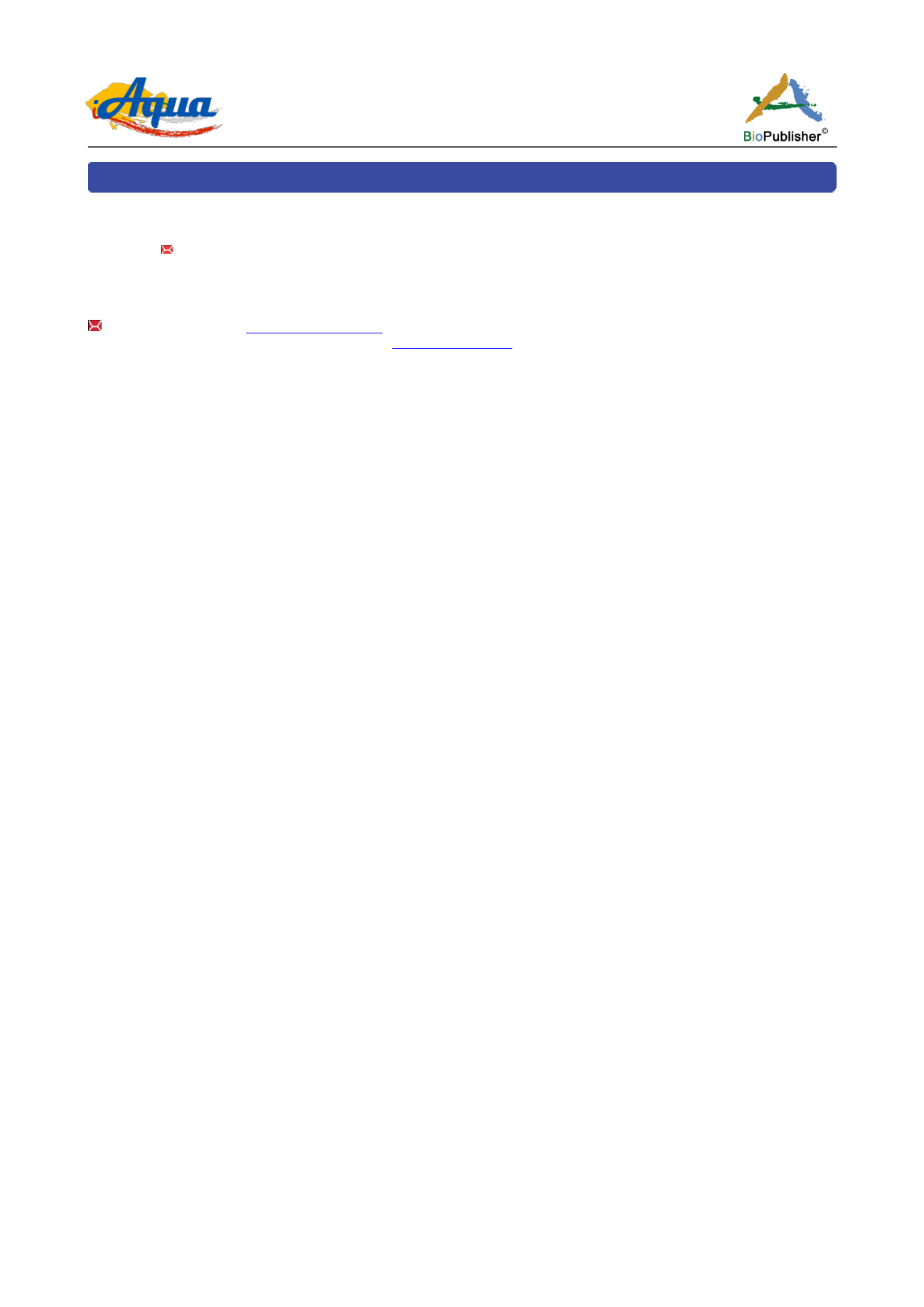
International Journal of Aquaculture, 2015, Vol.5, No.24, 1
-
5
1
Research Report Open Access
Effect of Stocking Density and Rearing Facility on Growth and Profitability of
Tilapia rendalli
Fry
Zidana H.
1,
, Phiri F.
1
, Kapute F.
2
, Ajiboye O.
3
, Singini W.
2
1. National Aquaculture Centre, P. O. Box 44, Domasi, Malawi
2. Mzuzu University, Private Bag 1, Mzuzu, Malawi
3. Aquaculture Department, Nigerian Institute for Oceanography and Marine Research, Sapele station, PMB 4015, Sapele, Delta State, Nigeria
Corresponding author Email
International Journal of Aquaculture, 2015, Vol.5, No.24 doi
Received: 03 Jun., 2015
Accepted: 07 Jul., 2015
Published: 06 Aug., 2015
Copyright © 2015
Zidana et al., This is an open access article published under the terms of the Creative Commons Attribution License, which permits unrestricted
use, distribution, and reproduction in any medium, provided the original work is properly cited.
Preferred citation for this article
:
Zidana H., Phiri F., Kapute F., Ajiboye O. and Singini W., 2015, Effect of Stocking Density and Rearing Facility on Growth and Profitability of
Tilapia rendalli
Fry, International Journal of Aquaculture, 5(24): 1-5
Abstract
A study was conducted to compare the growth potential of
Tilapia rendalli
at three different stocking densities, using
different rearing facilities.
T. rendalli
fry of 0.9±0.1g average weight were stocked in tanks and hapa-in-ponds at the stocking density
of 30, 60 and 90 fry/m
3
. Locally made feed (CP-18%) was administered at 5% body weight three times a day for three months.
Monthly sampling was conducted to assess growth by measuring weight and length for specific growth rate (SGR), average daily
gain (ADG), weight gain (WG), and biomass (BM). The results of the study showed a significantly higher (P < 0.05) growth rate in
low stocking density (30 fry/m
3
) as compared to 60 and 90 fry/m
3
. There was a highly significant (P < 0.05) growth rate from hapas
mounted in pond rearing facility as compared to tanks. There was no significant difference in profitability between the two rearing
facilities (P > 0.05) as well as within the stocking densities (P > 0.05). The results of this study have a significant contribution
towards stocking densities as well as rearing facilities used by hatchery operators. It is recommended that hapas mounted in pond fry
rearing for
T. rendalli
fingerling production is most ideal. The results of the present study suggested that production of good quality
fingerlings at stocking densities of 30 fry/m
3
must be adopted in the culture of
T. rendalli
as fish grows faster than the other stocking
densities of 60 and 90 fry/m
3
as demonstrated in this study.
Keywords
Tilapia rendalli
Fry; Stocking Density; Rearing Facility; Growth
Introduction
Tilapia, that is native to Africa and Middle East, has
emerged from mere obscurity to one of the most
productive and internationally traded food fish in the
world (Gupta and Acosta, 2004). It is a popular food
fish species with great aquaculture potentials in many
tropical and subtropical regions of the world (Ajiboye
and Yakubu, 2010). Global aquaculture production of
tilapias increased from 28,000 tonnes to over 3 million
tonnes from 1970 to 2012 (FAO, 2012). Currently,
tilapia is farmed commercially in almost 100 countries
worldwide, with over 98 percent of the production
occurring outside their original habitats (FAO, 2011).
Now, it is being regarded as both a commodity or
speciality crop such as poultry (Fitzsimmons, 2010).
The most cultured fish species in Malawi are Tilapias,
namely
Tilapia rendalli
,
Oreochromis shiranus
and
Oreochromis karongae
, which together account for
about 93% of production (Chirwa, 2009; Russell et al.,
2008). These herbivorous-cum-omnivorous fish have
a good aquaculture potential because they are
exceptionally hardy and prolific, easy to farm and
thus ideal for both small farmers and industrial sized
aquaculture (Chirwa, 2009; Maluwa and Gjerde, 2006).
Seed for tilapia can be basically produced through
three rearing facilities: pond, hapa and tank rearing
systems. According to Guerrero (2002), identified “best
practices” is important in any industry for providing good
and exact examples for a successful operation. Knowledge
on good aquaculture practises (GAPs) in tilapia farming
will ensure sustainably development in its farming by
employing environmentally and economically friendly
culture techniques (Orina et al., 2014). This would ensure
all-year round tilapia quality seed production and supply
to grow out farmers which is one of the constraints to the
industries’ production potential.
In Malawi, there is an increasing interest in the culture
of
Tilapia rendalli
. One of the major problems facing


